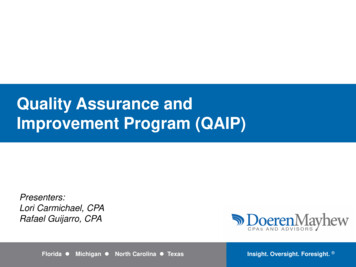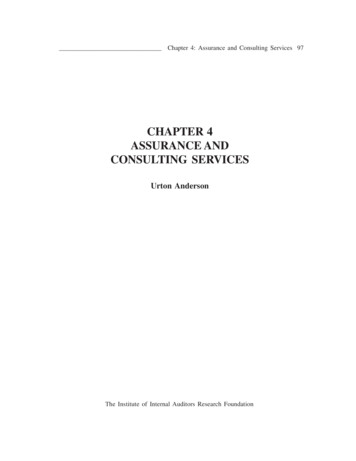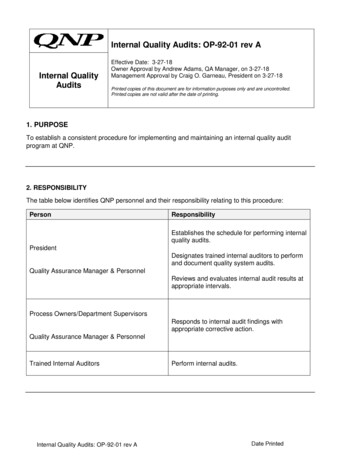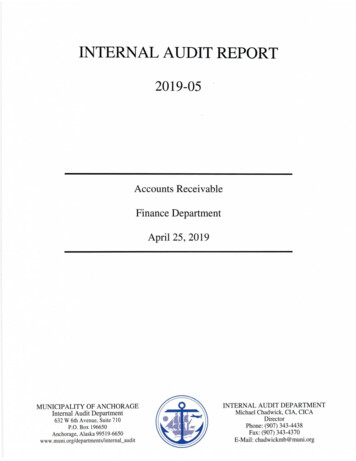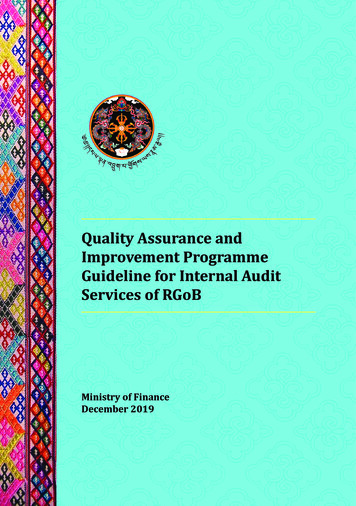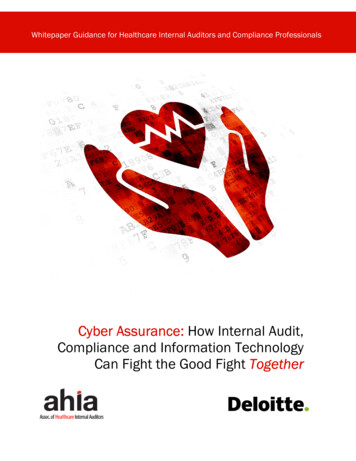
Transcription
Whitepaper Guidance for Healthcare Internal Auditors and Compliance ProfessionalsCyber Assurance: How Internal Audit,Compliance and Information TechnologyCan Fight the Good Fight Together
INTRODUCTIONHospitals, insurers, life sciences, and other healthcare organizations have been adopting newtechnologies at a breakneck pace. In fact, adoption has outdistanced many organizations’ abilityto identify, manage, and oversee the risks associated with those technologies.Board members of healthcare organizations need a clear understanding of the organization’soverall exposure to cyber risks but sometimes the picture is unclear. As a result, boards andtheir audit and compliance committees are calling upon internal audit and/or compliance toprovide assurance regarding the organization’s management of cyber risks. While thesegoverning bodies benefit from cyber security education provided by the chief informationofficer (CIO), chief technology officer (CTO), and chief information security officer (CISO),education efforts can fall short of the boards’ needs for clarity and understanding for threereasons: Information Technology and Security department reports and presentations are oftencomplex, difficult to connect to business objectives, and focused primarily on technicalrisks that may put the board in unfamiliar territory. Boards aren’t currently required toinclude cybersecurity technical specialists; existing members may be more comfortablewith financial or operational internal controls and regulations. IT and security functions cannot provide the independent, objective assurance thatboard members desire when it comes to cybersecurity. Due to news reports of breaches and emerging legislation from regulatory,governmental and auditing entities, many board members have a heightened awarenessof cyber risks.Technology adoption follows the same trajectory in healthcare as it does in many organizations:adoption comes first and if the technology adds value for patients, providers, customers, andother stakeholders, it is institutionalized. Only after technology is institutionalized—and posessignificant threats—do most management teams seriously address a technology’s risks.Creating a risk management program prematurely is arguably wasteful, but organizations thatdelay too long may find themselves playing catch-up to address technology adoption risks.This delay and struggle to catchup cycle is evident in the adoption of mainframe computers,personal computers and the Internet, mobile devices, cloud computing, and our current age oftotal digitalization. These technologies are so pervasive and varied that we simply use the term“cyber” to describe the environment and related risks.Cyber risks may present challenges for healthcare internal audit and compliance functions inevolving their cyber assurance program and capabilities. Discussions with board members andsenior executives indicate an increasing desire for assurances related to cyber risks andcybersecurity beyond Information Technology reporting; in the near future, cyber auditing maybe business as usual much like Sarbanes-Oxley (SOX) audits. No other organizational functionshave the independence, objectivity, organization-wide perspective, and skill sets needed to
deliver that assurance. While specific cyber risk assessment and auditing skills may be in shortsupply, they can be acquired through training, rotational programs, and co-sourcing. Externalassistance can help internal audit and compliance develop a comprehensive view of cyberassurance needs.The key question for both the internal audit and compliance functions that have yet to engage incyber assurance is how to go about it. Although cyber assurance may seem daunting, it is a fairlystraightforward process if undertaken systematically.WHERE TO BEGINBegin with the rationale. Boardmembers and management needindependent assurance on theeffectiveness of cybersecurity riskmanagement and controls. Assurance isnot just a “one and done,” effort;rather it should be a consistentmeasurement of the cybersecurityprogram based on an assurance cycle.Moreover, after an assurance programhas been established, internal auditand/or compliance can also provideconsultative support to managementaround cybersecurity.Perhaps the best rationale for a cyberassurance program is enablement ofinternal audit as the third line of defense in risk management and governance (the first line isoperations, and the second line is internal control monitoring, compliance, and riskmanagement). Management and, ultimately, the board are responsible for understanding andaddressing the full range of risks posed to the organization. Internal audit’s role as anindependent assurance provider is essential to sound risk management and governance.
LINES OF DEFENSEAfter the rationale is accepted, the cyber assurance plan should be defined. A solid cyberassurance plan should be: Structured as an ongoing risk-based program Built around a cyber assurance framework Executed on an assurance cycleAn Information Security risk-based program recognizes that different assets and risks requiredifferent levels of risk management. To gauge resource allocations, the organization must firstunderstand which digital assets are most valuable, the vulnerability of those assets, and thelikely impact if those assets were compromised or stolen. Valuable assets include patientrecords and customer data, contracts and plans, analytics related to fees and services, ongoingor completed research and other intellectual property, and personal information onorganizational leaders and staff. In addition, biomedical devices used for patient treatment andmonitoring and other applications specific to the organization must be appropriately secure.One key goal is to identify the “crown jewels”—the digital assets with the highest value, whichrequire the highest levels of protection. Next, the analysis identifies other digital assets and thelevels of protection they warrant based on their value and vulnerability. This risk-basedapproach then tailors cyber assurance activities to the value and vulnerability of digital assets.A cyber assurance framework is perhaps the most important component; it is the yardstick thatmeasures the program and promotes understanding of the cyber risks the organization faces.
Although no standardized framework currently exists that addresses all of the cyber assuranceissues that an audit committee faces, organizations have presented frameworks that focus onaspects of cyber risk. These organizations include the National Institute of Standards andTechnology (NIST), the International Organization for Standardization (ISO), the Committee ofSponsoring Organizations of the Treadway Commission (COSO), ISACA, and the Center forInternet Security (CIS). These organizations’ frameworks have specific areas of focus, such asinformation security or technology risk, and elements of those frameworks have been adoptedby primary stakeholders with responsibility for cyber risk.An organization can also create its own cyber assurance framework based on applicableelements of existing frameworks. A comprehensive framework specific to healthcare shouldinclude alignment with the Health Insurance Portability and Accountability Act (HIPAA) and theHealth Information Technology for Economic and Clinical Health Act (HITECH).Comprehensive cyber assurance frameworks are developed to assist internal audit and/orcompliance and can be customized to an organization’s specific requirements and environment.An organization’s framework should be rationalized and focused on cyber assurance needs, thespecific coverage areas desired by internal audit and/or compliance, and aligned with relevantindustry standards such as NIST, ISO, COSO, HIPAA, HITECH and other leading practices.Example: Cyber Assurance Framework
A comprehensive cyber assurance framework helps organizations maintain a secure, vigilant,and resilient environment and identifies specific domains and characteristics that contributetoward that end.This framework enables the team to consider a wide range of risks across various domains andsets the stage for a comprehensive risk assessment, a necessary early step in virtually any riskmanagement, governance, and assurance effort. The framework also promotes broaddiscussion, review, and reporting of cyber risks and cyber risk management mechanisms.An assurance cycle ensures that cyber risks receive targeted levels of audit attention. Theassurance cycle should relate to the value of digital assets and potential threats, rather than to arigid periodic cycle. Scheduled cyber audits of specific domains will help ensure appropriateareas are reviewed, but the cycle should be dynamic rather than static. For example, criticaldomains might be reviewed annually or biannually while less critical ones could be reviewedonce or twice in a three-year period. Domains subject to newly emerging threats should receivefocused attention as well.The assurance cycle should link to regulatory mandates while recognizing that cyber threatsusually outpace regulatory review and reporting requirements.GETTING WITH THE PROGRAMA program approach includes a comprehensive risk assessment that leads to a multi-year plan ofrisk-based assurance cycles. With the plan in place, program execution can begin.Program execution calls for the right people with the right skills, which can present a challenge.Recent research1 found that 45 percent of surveyed chief audit executives (CAEs) in life sciencesand healthcare (LSHC) organizations view specialized IT skills—that is, cyber domain-specificskills—as the second largest skill gap their internal audit and compliance groups face in the nextthree to five years (after data analytics skills, at 49 percent). Only 20 percent of surveyed LSHCCAEs noted that their groups currently have those skills in-house. Skill gaps can be addressedthrough outsourcing, co-sourcing, and training, and they must be addressed if internal audit andcompliance are to provide the assurance boards are now seeking.Execution also calls for the right tools, tests, and questions. Useful questions for internal audit toask include: Where might we be allocating too many resources to protect low-value digital assets?1 Evolution or irrelevance? Internal Audit at a crossroads Deloitte’s Global Chief Audit Executive Survey, 2016, DeloitteTouche Tohmatsu Limited www.deloitte.com/globalCAEsurvey
Where might we be allocating too few resources?How might the organization rationalize, harmonize, and optimize cyber controls andcompliance efforts?How can we reduce the cost and increase the quality of cyber risk management?Program execution flows through to reporting, which should be accurate, timely, relevant, anduseful to stakeholders. Avoid IT jargon. Speak the language of business and risk management.Use visualization tools, such as heat maps and bubble charts, to bring out key points andrelationships for stakeholders.The simplified chart below maps back to the domains in the Cyber Assurance Framework andshows how the organization’s risk management can be characterized as adequate(green/unshaded), of concern (yellow/lightly shaded), or of serious concern (red/darkly shaded).An actual report would provide indicators at finer levels of domain detail so stakeholders couldhone in on specific concerns.Sample Cyber Risk Reporting ToolCopyright 2017 Deloitte Development LLC. All rights reserved.
Visualization tools enable internal audit to communicate more effectively. These tools alsoenable internal audit to expand on areas “of concern” and let users who want more detail todrill down.While internal audit can, and should, initiate the effort to provide or upgrade cyber assurance,this should not be a unilateral effort. A sustainable cyber assurance program calls for seniorexecutive support, adequate resourcing, and strong organizational commitment.ESTABLISH A STEERING COMMITTEETo initiate a higher level of cyber assurance and obtain ongoing guidance, the organizationshould form a cybersecurity steering committee. This committee should include seniorrepresentatives of compliance, internal audit, information security, information management,legal, data owners and business management. Reporting to the board’s audit and/or compliancecommittee, this committee: Assists the audit and/or compliance committee in establishing strategy, expectations,and accountability for cybersecurity and cyber incident preparednessEvaluates available internal and external resources and recommends funding to initiateand maintain an effective cybersecurity and cyber assurance programRecommends enhancements to existing and future cybersecurity initiatives, andengages in discussion and approval of the cyber assurance framework and otherprogram components.This committee facilitates senior-level engagement, demonstrates organizational commitmentto cybersecurity and cyber assurance, and enables the planning and resourcing needed tolaunch and maintain the cyber assurance program. If the committee already exists, internalaudit should assess its member coverage. The existing committee may solely focus onInformation Technology and fail to incorporate the broader organizational stakeholders whomare also impacted and play a role in cyber security.Respond Now to Rising RisksAs media reports of breaches regularly remind us, no organization is immune to cyber risks,threats, and incidents. Board members and senior executives in healthcare understand thatthose managing cybersecurity cannot provide objective, independent assurance on cyber risksor on the organization’s ability to address those risks. These stakeholders are looking to internalaudit to provide that assurance. This is the time for internal audit and compliance to worktogether to plan, resource, and initiate a cyber assurance internal audit program. Taking actionnow can reduce pressure when cyber assurance requirements are promulgated over the near tomedium term. Benefits include enhanced security for digital assets, improved compliance withrelated regulations, and greater organizational impact and influence for internal audit andcompliance.
ABOUT THE AUTHORSDebra A. MuscioSVP, Chief Audit, Ethics and Compliance OfficerCommunity Medical CentersFresno and Clovis, CAMs. Muscio is driven to help the internal audit and complianceprofession raise the bar on security compliance awareness, riskassessments, remediation, monitoring and auditing by aligning teamsthat communicate and collaborate to achieve their goals. With over 30years of experience in the Internal Audit and Compliance profession, she has championed thealignment of Security Compliance and Audit with independent reporting to the audit andcompliance committee of the board. She has served on various boards and committees in theHealthcare Audit and Compliance Profession and continues to educate and mentor leaders at alllevels to enhance knowledge and awareness.Glenn M. WilsonInternal Audit Senior Manager, Deloitte & Touche LLPCyber Assurance ServicesLike you, Mr. Wilson is driven to raise the bar on security by helpingorganizations lower their risk. With over two decades of technical,real-life, in-the-trenches information security experience, his view onsecurity can be radically different. Glenn helps many of the world’slargest organizations reduce their risk by helping them manage cybermore effectively. He has governed as chief information officer (CIO),served over a dozen boards, educated audiences, and has the keenability to translate complex technical issues into plain English forexecutives and other decision makers.ContactsDeloitteGlenn M. WilsonCommunity Medical CenterDebra MuscioDeloitte & Touche LLP555 West Fifth St. Suite 2700, Los Angeles, CA 90071-3462Tel/Direct: 1 213-688-6976 Fax: 1 213-673-5879 Mobile: 1 949-612-5589glennwilson@deloitte.com www.deloitte.comLinkedIn: http://www.linkedin.com/in/gmw13Twitter: https://twitter.com/DeloitteGlenn789 N. Medical Center Drive East, Clovis, CA 93611-6878Office 1 559-324-4830dmuscio@communitymedical.org
This publication contains general information only and Deloitte is not,by means of this publication, rendering business, financial,investment, or other professional advice or services. This publication is not a substitute for suchprofessional advice or services, nor should it be used as a basis for any decision or action thatmay affect your business. Before making any decision or taking any action that may affect yourbusiness, you should consult a qualified professional advisor. Deloitte shall not be responsible forany loss sustained by any person who relies on this publication.As used in this document, “Deloitte” means Deloitte & Touche LLP, a subsidiary of Deloitte LLP.Please see www.deloitte.com/us/about for a detailed description of our legal structure. Certainservices may not be available to attest clients under the rules and regulations of publicaccounting.The Association of Healthcare Internal Auditors (AHIA) is a network ofexperienced healthcare internal auditing professionals who cometogether to share tools, knowledge and insight on how to assess andevaluate risk within a complex and dynamic healthcare environment.AHIA is an advocate for the profession, continuing to elevate andchampion the strategic importance of healthcare internal auditors with executive managementand the Board. If you have a stake in healthcare governance, risk management and internalcontrols, AHIA is your one-stop resource. Explore our website for more information. If you are nota member, please join our network, www.ahia.org.AHIA white papers provide healthcare internal audit practitioners with non-mandatory professionalguidance on important topics. They are intended to supplement and support the mandatoryrequirements of formal professional standards. By providing healthcare specific information andeducation, white papers can help practitioners evaluate risks, develop priorities and design auditapproaches. A white paper is an authoritative report or guidance that informs readers conciselyabout a complex issue and presents the issuing body's philosophy on the matter. It is meant to helpreaders understand an issue, solve a problem or make a decision. AHIA welcomes papers aimed atbeginner to expert level practitioners. This includes original content clearly related to healthcareinternal auditing that does not promote commercial products or services. Interested?Contact a member of the AHIA White Paper Subcommittee:Alan Henton, AHIA White PaperSubcommittee Chairalan.p.henton@vanderbilt.eduMark Eddymark.eddy@hcahealthcare.comLinda McKeelsmckee@sentara.comMark Ruppertmruppert@socal.rr.comDebi Weatherforddebi.weatherford@piedmont.orgTodd Havens, AHIA Board Liaisontodd.havens@vanderbilt.edu
“cyber” to describe the environment and related risks. Cyber risks may present challenges for healthcare internal audit and compliance functions in evolving their cyber assurance program and capabilities. Discussions with board members and senior executives indicate an increasing desire f



